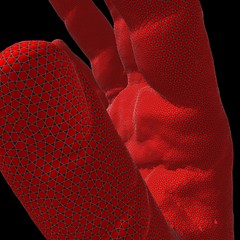 |
| There are three regular tessellations of the plane. Image quoted from Grunbaum and Shephard, "Tilings and Patterns an Introduction." |
There are three regular tessellations of the plane (i.e., by triangles, by squares, and by hexagons) but only two regular ways to weave (a consequence of the fact that the tessellations by triangles and by hexagons are dual, thus not truly distinct.)
 |
| Tabby weave (yotsume ami.) |
The first-discovered weave, based on the tessellation by squares, called tabby weave or
yotsume ami in Japanese,
was in use by 27,000 BP.
 |
| Kagome weave (mutsume ami.) |
The weave based on tessellation by triangles/hexagons, called kagome weave or
mutsume ami in Japanese,
was in use by 7,000 BP.
 |
A kagome weaving of wooden strips found at Higashimyo, Japan dating to 7,000 BP. Image quoted from http://archaeology.jp/sites/2007/higashimyo.htm .
|
In the recent era (19th century to present) has come the realization that all such strictly over-and-under weaves can be mathematically flattened to two-dimensionality by describing the openings of the fabric rather than the paths of the weaving elements.
 |
| Flattening an over-and-under weave: the checkerboard diagram of an alternating knot. Image quoted from P. G. Tait, "Some elementary properties of closed plane curves." (1876.) |
A close look at any fabric that is woven over-and-under will show that the fabric openings have a resemblance to an impossible staircase.
 |
| A Penrose stairs or Escher staircase. |
Proceeding around the fabric opening (clockwise or counter-clockwise) produces an apparent progression in the vertical direction (up or down) that ultimately proves illusory. By associating the direction of procession (clockwise or counter-clockwise) with curled fingers and the direction of progress (up or down) with the extended thumb, it is possible to categorize every opening in the fabric as either left-handed or right-handed. Importantly, we will categorize the opening the same way whether we view it from the front or the back: weaving a non-orientable surface does not encounter any contradictions in the weaving.
If we narrow the weaving elements until the basket surface becomes "all holes," and color each hole according to its left- or right-handedness, gives us a description of a basket as a surface colored like a chessboard or checkerboard. A every corner four tiles, two of each color, meet and no two tiles of the same color are ever found side-by-side.
 |
| A checkerboard graph describing a kagome basket. |
Every graph can be converted into a checkerboard graph through a procedure called medialization, so all we need to weave a basket is a graph drawn on a surface. (A visual short-cut is to imagine growing the black dots that represent the graph's vertices out along their adjacent edges until they meet at mid-edge—what you will have left is a black and white checkerboard graph.)
From this graph theory perspective on weaving comes the realization that tabby weave and kagome are essentially the same thing. These two types of weave, one Paleolithic and the other Neolithic, can intermix as freely as triangles and quadrangles in a tessellation.
 |
| Triangles and quadrangles can mix fairly freely in a tessellation. After medialization, the result is a checkerboard graph describing a hybrid tabby/kagome weave. |
Now we can weave any surface essentially any way we want. But there are problems. The
weavers (weaving elements) will generally not be straight, and, except in tabby weave passages, coverage of the surface will not be 100%.
 |
| The perpendicular and oblique creases in knotology weavers allow them to weave any combination of (flat) tabby weave and (corrugated) kagome. Image quoted from www.origami-guide.com |
Enter Heinz Strobl in the 1990's with his knotology technique. Knotology uses identically creased, straight weavers to weave any combination of tabby weave and kagome. The kagome passages are corrugated (which contributes stiffness to the basket wall) and coverage is 100%. The one constraint: the quadrangles must be squares and the triangles must be equilateral.

















































